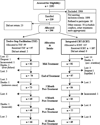Clinical outcomes of an integrated treatment for depression and substance use disorders
- PMID: 20853931
- PMCID: PMC3609717
- DOI: 10.1037/a0019943
Clinical outcomes of an integrated treatment for depression and substance use disorders
Abstract
The authors compared longitudinal treatment outcomes for depressed substance-dependent veterans (N = 206) assigned to integrated cognitive-behavioral therapy plus standard pharmacotherapy (ICBT + P) or 12-step facilitation therapy plus standard pharmacotherapy (TSF + P). Drug and alcohol involvement and depressive symptomology were measured at intake and at 3-month intervals during treatment and up to 1 year posttreatment. Participants in both treatment conditions showed decreased depression and substance use from intake. ICBT + P participants maintained improvements in substance involvement over time, whereas TSF + P participants had more rapid increases in use in the months following treatment. Decreases in depressive symptoms were more pronounced for TSF + P than ICBT + P in the 6 months posttreatment. Within both treatment groups, higher attendance was associated with improved substance use and depression outcomes over time. Initial levels of depressive symptomology had a complex predictive relationship with long-term depression outcomes. Early treatment response predicted long-term substance use outcomes for a portion of the sample. Although both treatments were associated with improvements in substance use and depression, ICBT + P may lead to more stable substance use reductions compared with TSF + P.
Figures




Similar articles
-
Psychological interventions for co-occurring depression and substance use disorders.Cochrane Database Syst Rev. 2019 Nov 26;2019(11):CD009501. doi: 10.1002/14651858.CD009501.pub2. Cochrane Database Syst Rev. 2019. PMID: 31769015 Free PMC article.
-
Mechanisms of action in integrated cognitive-behavioral treatment versus twelve-step facilitation for substance-dependent adults with comorbid major depression.J Stud Alcohol Drugs. 2007 Sep;68(5):663-72. doi: 10.15288/jsad.2007.68.663. J Stud Alcohol Drugs. 2007. PMID: 17690799 Clinical Trial.
-
Integrated cognitive behavioral therapy versus twelve-step facilitation therapy for substance-dependent adults with depressive disorders.J Psychoactive Drugs. 2006 Dec;38(4):449-60. doi: 10.1080/02791072.2006.10400584. J Psychoactive Drugs. 2006. PMID: 17373561 Clinical Trial.
-
Neuropsychological functioning and outcomes of treatment for co-occurring depression and substance use disorders.Am J Drug Alcohol Abuse. 2011 Jul;37(4):240-9. doi: 10.3109/00952990.2011.570829. Epub 2011 Apr 26. Am J Drug Alcohol Abuse. 2011. PMID: 21517712 Clinical Trial.
-
Nonsomatic treatment of depression.Child Adolesc Psychiatr Clin N Am. 2002 Jul;11(3):579-93. doi: 10.1016/s1056-4993(02)00009-3. Child Adolesc Psychiatr Clin N Am. 2002. PMID: 12222084 Review.
Cited by
-
Work-family conflict and alcohol use: examination of a moderated mediation model.J Addict Dis. 2013;32(1):85-98. doi: 10.1080/10550887.2012.759856. J Addict Dis. 2013. PMID: 23480251 Free PMC article.
-
Treatment of comorbid alcohol use disorders and depression with cognitive-behavioural therapy and motivational interviewing: a meta-analysis.Addiction. 2014 Mar;109(3):394-406. doi: 10.1111/add.12441. Epub 2014 Jan 16. Addiction. 2014. PMID: 24304463 Free PMC article. Review.
-
Self-efficacy and social networks after treatment for alcohol or drug dependence and major depression: disentangling person and time-level effects.Psychol Addict Behav. 2014 Dec;28(4):1220-9. doi: 10.1037/a0037901. Epub 2014 Oct 27. Psychol Addict Behav. 2014. PMID: 25347018 Free PMC article.
-
Treatment Attendance Among Veterans With Depression, Substance Use Disorder, and Trauma.J Dual Diagn. 2016;12(1):15-26. doi: 10.1080/15504263.2016.1146384. J Dual Diagn. 2016. PMID: 26828770 Free PMC article. Clinical Trial.
-
Efficacy of Cognitive Behavioral Therapy on Opiate Use and Retention in Methadone Maintenance Treatment in China: A Randomised Trial.PLoS One. 2015 Jun 24;10(6):e0127598. doi: 10.1371/journal.pone.0127598. eCollection 2015. PLoS One. 2015. PMID: 26107818 Free PMC article. Clinical Trial.
References
-
- Alterman AI, Brown LS, Zaballero A, McKay JR. Interviewer severity ratings and composite scores of the ASI– a further look. Drug and Alcohol Dependence. 1994;34:201–209. - PubMed
-
- Blume AW, Schmaling KB, Marlatt GA. Revisiting the self-medication hypothesis from a behavioral perspective. Cognitive and Behavioral Practice. 2000;7:379–384.
-
- Brown SA, D’Amico EJ. Outcomes for alcohol treatment for adolescents. In: Galanter M, editor. Recent developments on alcoholism: Vol. XVI. Selected treatment topics. New York: Plenum; 2001. pp. 307–327. - PubMed
-
- Brown SA, Glasner-Edwards SV, Tate SR, McQuaid JR, Chalekian MS, Granholm E. Integrated cognitive behavioral therapy versus twelve-step facilitation therapy for substance dependent adults with depressive disorders. Journal of Psychoactive Drugs. 2006;38:449–460. - PubMed

